

We are on a mission to unlock everyone’s potential with the power of software! Our combined approach of AI, automation and talented humans means that your background, tech knowledge or budget will never hold you back.
Kick-off your app project today
A few years back, you needed either a bottomless pit of money or coding skills to build an app. But now, things have changed.
Anyone who wants to invest in an app development project – regardless of their budget or tech expertise – has the ability to do so.
The question is, which option is best for you? And what does the process actually look like when you create an app from scratch?
In this blog, we’re going to help you answer both of these questions. But before that, I’d like to signpost some helpful key resources…
The following pieces will help to provide extra context on all the steps we cover in this blog, ensuring that you're well-prepared for every step in your app development journey:
Now, let’s get into the nitty gritty 👇
There are many ways you can go about creating your app. However, the size of your business, the resources at your disposal and the purpose of your application all influence your app development route.
We’ve broken down the pros and cons of the four most established app creation methods below:
Self code
Freelancer
No-code app builder
Dev agency
Builder.ai
Budget friendly
Fast development speed
High customizability
Beginner friendly
Clear timelines
Keep your code
Fully managed service
If you have technical skills and you don't have strict project deadlines, coding your own app is the most attractive app building route. Here's everything you need to know:
Working with freelancers can be a great option if you’re on a shoestring budget and can work without clear timelines. Sites like Upwork and Fivver make it easy to find freelancers with the skillset you’re looking for.
No-code app builders are app-building software platforms. They allow non-technical users to quickly and cost-effectively build simple web and mobile apps and have the following up and downsides:
If your developers don't have the resources to dedicate to a mobile app development project, or you don't quite have the capacity to hire an internal team, you're in luck. Because plug-and-play teams can fill the gap and build powerful, custom-code apps. Here's what you need to know:

Builder.ai is an all-in-one solution, offering a middle ground between no-code app builders and dev agencies. On the one hand, you can create apps cost-effectively and at speed. On the other hand, you’re not restricted by templates and can create custom functionality tailored to the exact needs of your users.
This means everyone – from non-technical users founding their own startups to large enterprises looking for extra resources – can use the platform.
Speak with one of our product experts today.
By proceeding you agree to Builder.ai’s privacy policy and terms and conditions

By now, you’ve either decided that you’re creating your app yourself or you’re working with an app development partner.
The following guide will be most relevant to people in the latter category, so if you’re coding your own app from scratch, we wish you luck and bid you farewell.
For everyone else, keep scrolling 👇
There are umpteen different motivations for greenlighting an app project.
Maybe you’re starting to sell online. Maybe you want to scale your business up. Maybe you want to improve organisational efficiency.
Hell, you might even want to change the world.
But whatever it is, you need a North Star. Otherwise, it’ll be too easy to mainline TikTok content and push your project aside.
Establishing well-defined goals ensures your app development efforts remain focused and aligned with your overarching objectives.
Don’t know how to define your goals? Don’t worry.
Start by writing down your vision and mission. Your vision would be the end goal of your app and your mission is what you need to do to achieve that vision.
After you’ve done that, set out your business objectives. Make them SMART (specific, measurable, achievable, relevant and time-bound). For instance, a couple of your key goals could be to:
Unfortunately, a lightbulb moment doesn’t necessarily translate into a successful app.
Instead, you need to refine your app idea and work out exactly how it’s going to support your goals.
A problem statement helps you do just this.
In it, you’ll collect all the info on the problem you’re trying to solve, who your target audience is, what their pain points are and your solution. Here’s how you can do just that:
As the legendary boxer Mike Tyson once said, "Everyone has a plan until they get punched in the face." When you’re developing an app from scratch, this rings true.
So if you want minimise the amount of punches you receive, you need to assess your competitors’ app positioning, marketing and pricing strategies. This'll allow you to reverse-engineer their strengths and take advantage of their weaknesses.
Performing an app competitive analysis is key to effectively positioning your app and building features that allow you to win a market share. This is especially important as the new kid on the block, without the brand recognition of more established players.
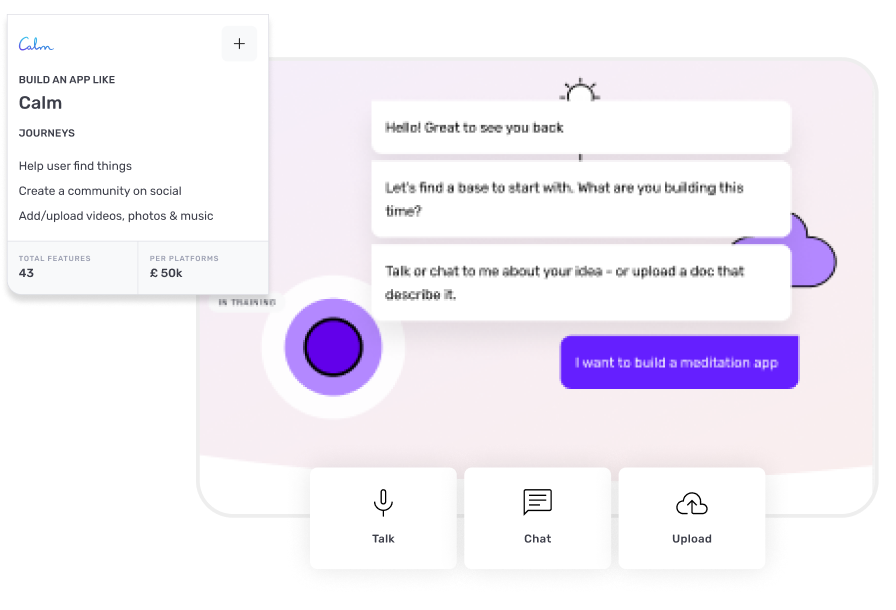
When using an app builder, you can pick from a wide range of pre-designed features and templates which align with the type of app you want to create.
For instance, mental health apps share lots of common features, with minor differences in the layout and themes.
With a no-code app builder, you choose the features you need via a drag-and-drop interface. While this is practical, it can be hard to know exactly what you do and don't need – especially if you don't have a technical background.
To make this process easier, our AI Product Manager, Natasha, finds relevant app templates for you, based on your inputs. All you need to do is chat through your ideas with her through voice, text or document upload and she’ll give you precise feature recommendations.
These features are organised into journeys, with each journey representing a specific goal someone using your app might have – for example, “help young professionals find meditation courses”.
This journey would include features to split these courses into different audience groups like “beginners” and “advanced” to help users find the most appropriate course for them.
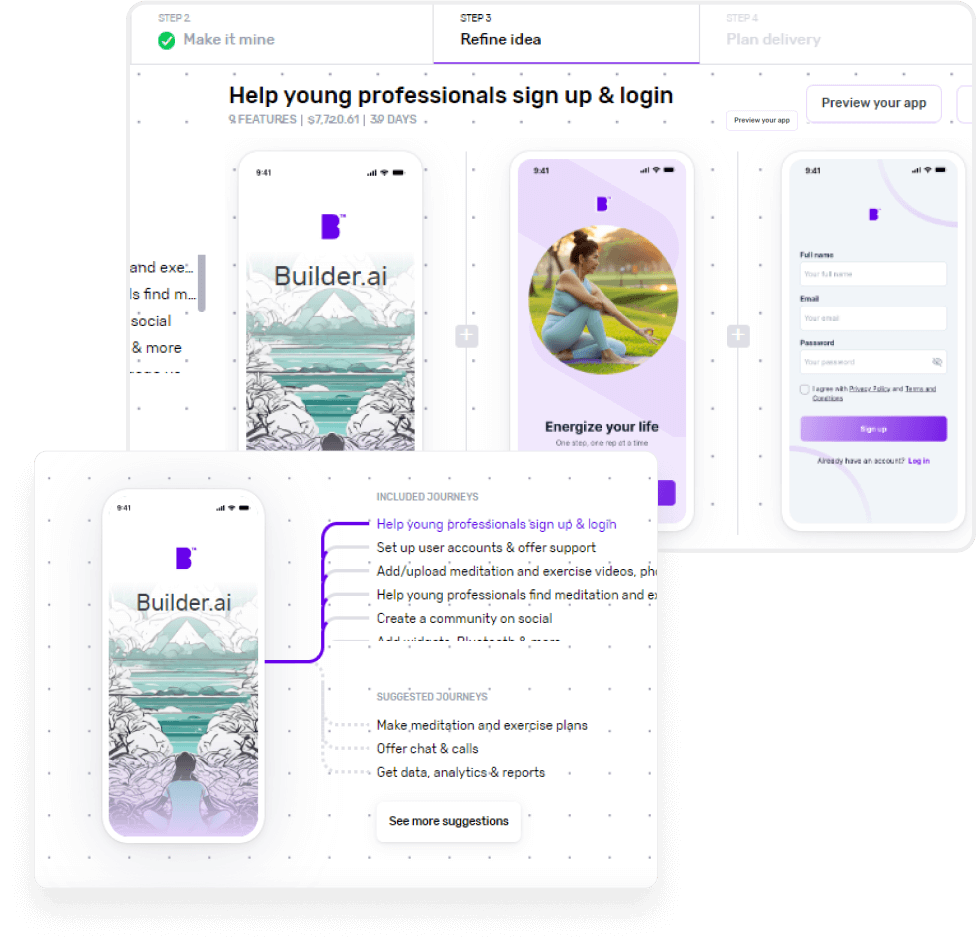
Once Natasha has suggested the journeys your app needs, you review them, adding and subtracting extra or unnecessary journeys.
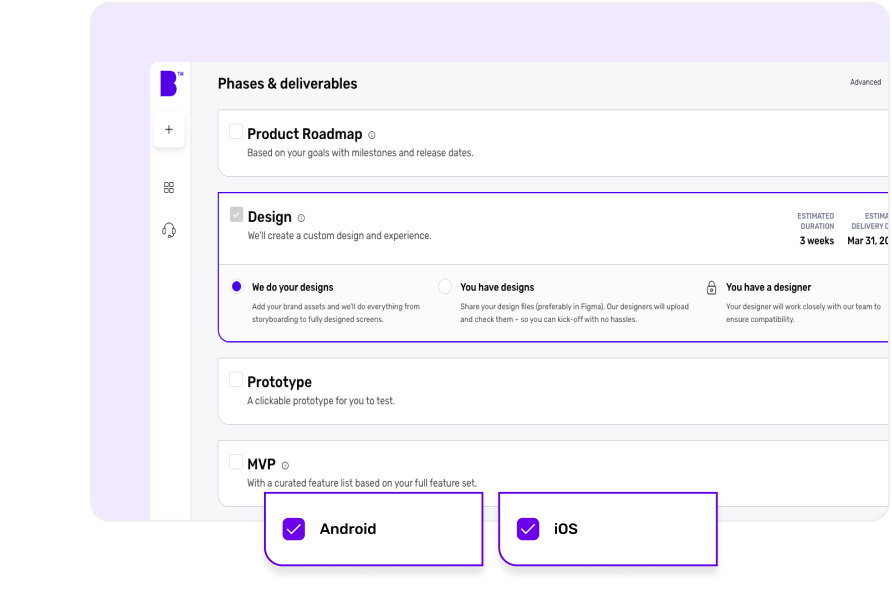
Deciding on the mobile platform you want to prioritise should be a walk in the park, whether that’s creating an app for Android or developing an iOS app.
One problem you may encounter is if you have 50/50 split between your user base.
This is why it’s helpful to work with Builder.ai, as our native app development helps you create apps for both mobile platforms simultaneously.
You also have the option to choose different project types, whether that’s an app design, an app prototype or an MVP.
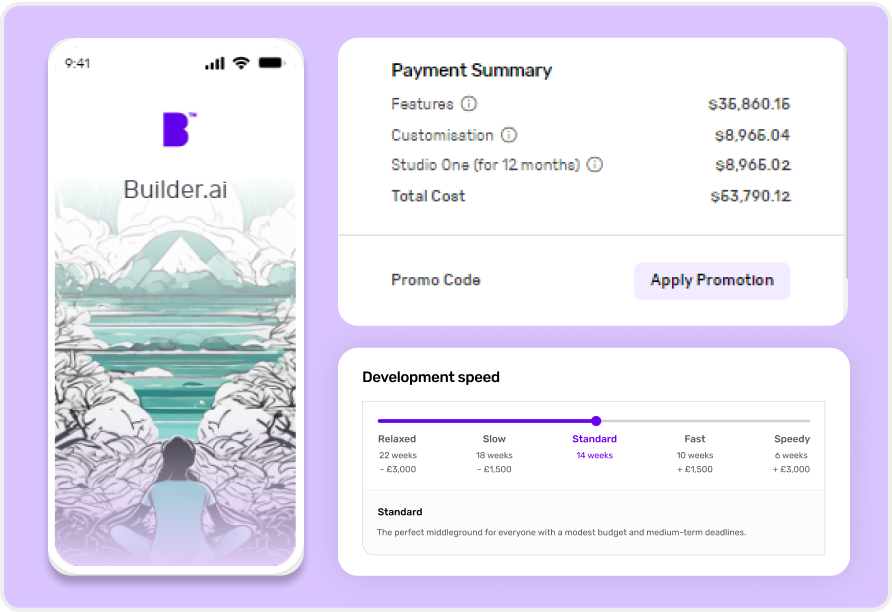
As most no-code app builders operate on a software-as-a-service (SaaS) payment model and most development agencies charge by the hour, it can be challenging to get a straight answer about your app development costs.
However, Builder.ai charges per feature.
This allows us to give you a complete breakdown of all your costs before you commit to your project, ensuring there are no nasty surprises down the line.
You can also choose your development speed with prices adjusting according to option you choose; for example, “Speedy” costs more than “Relaxed”.
And if your app takes us longer than expected to develop any of your features, we cover the costs, rather than charging you extra billable hours.
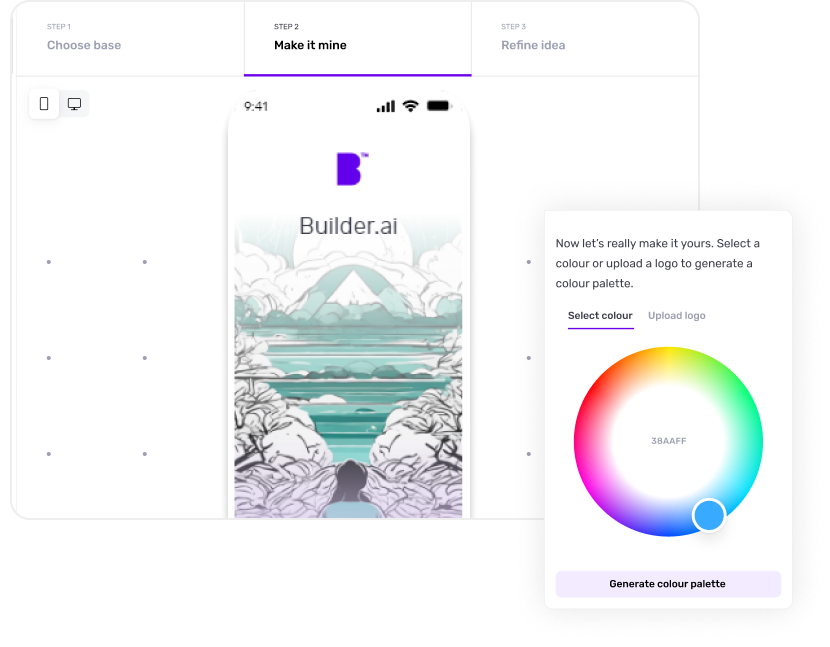
When you create an app with Builder.ai, you can instantly see how your app will look by giving Natasha your brand colour, logo and website URL. She imports this information to give you an accurate preview of your app design.
Here’s what the whole design process looks like:
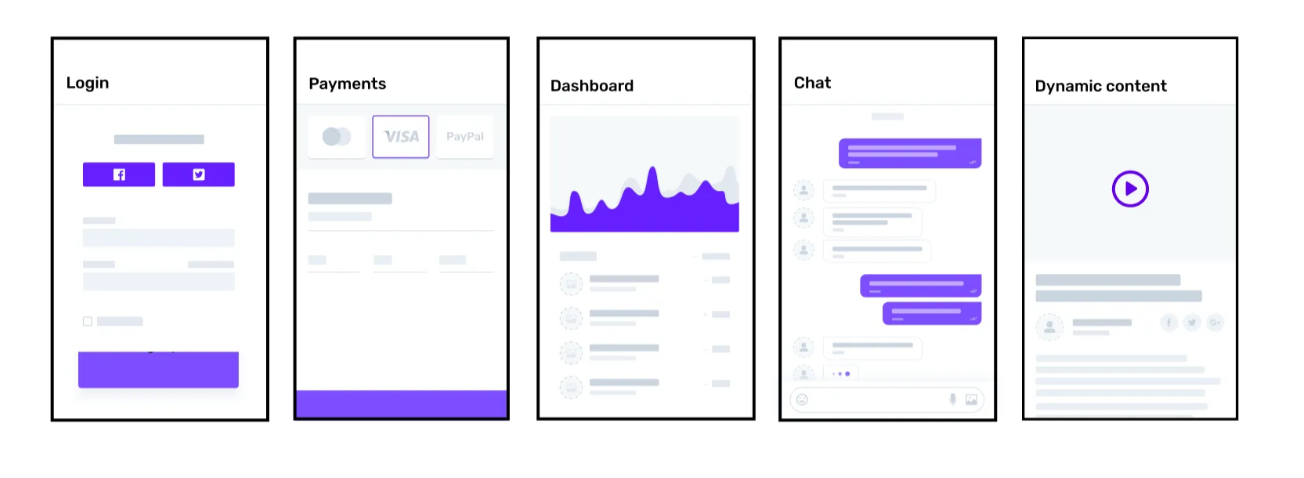
Wireframes serve as a skeletal blueprint of your app designs, outlining the layout, structure and functionality of your app’s screen and features.
That means in their early stages, they lack detailed visuals, colours and graphics. But as they progress and elements are added, they become mockups.
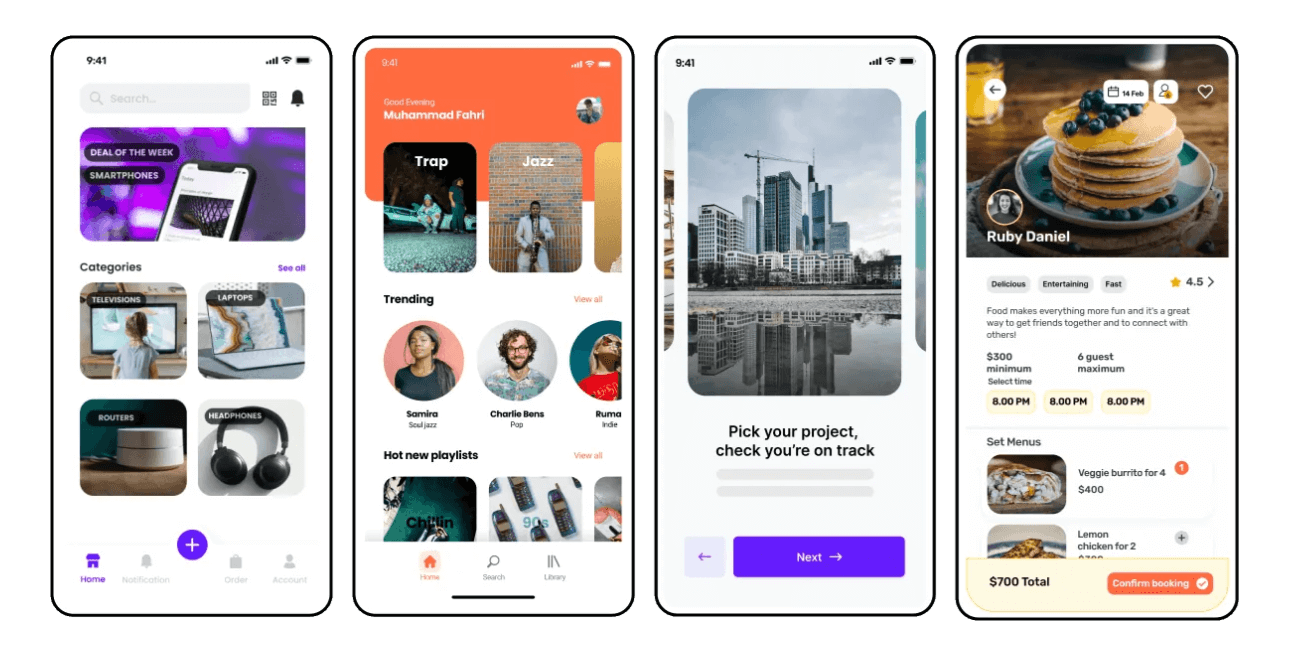
An app mockup is a visual representation of your app's design. It's essentially a screenshot of your app's layout, user interface and overall design elements, but doesn't have any functionality.
They’re different from wireframes as they contain more stylistic UI details and show how your app will look after production.
While creating an app mockup, you need to think about fonts, background colour palette, white spaces, content layout, typography and everything visual.
Once you have this, you can move to the prototyping stage.
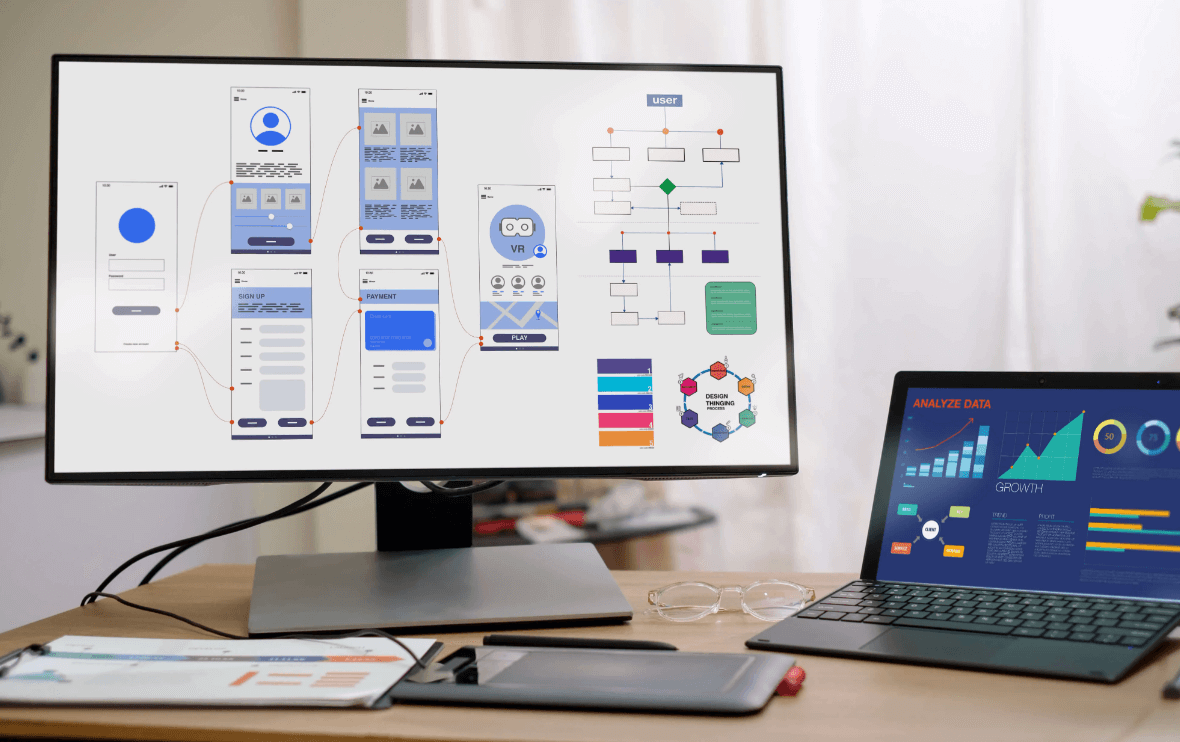
An app prototype is a fully functional, interactive mockup that has clickable features and looks similar to the final product.
It’s one step ahead of the app mockup that combines both the UI and UX elements of your app.
Where mockups give you the “look” of the final product, prototypes allow you to experience and get the “feel” of the final product.
Importantly, this allows you to get feedback from other stakeholders, iterate on your initial design layouts before actually coding your app.
As a result, you can keep development costs to a minimum by avoiding mistakes early on in the app-making process.
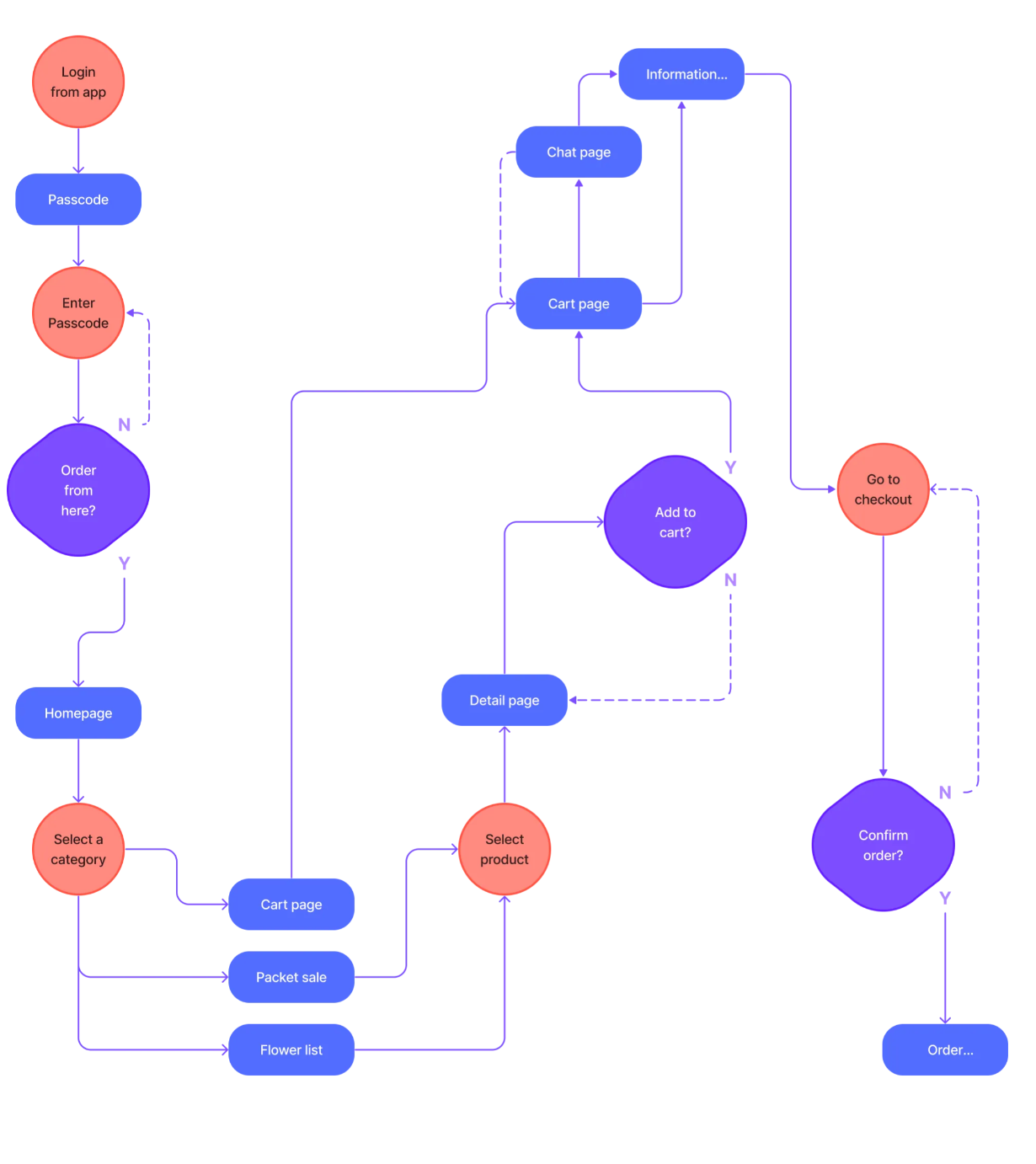
When designing your app, Builder.ai’s app designers create an intuitive user interface (UI) that enhances user experience (UX).
The goal of UI design is to facilitate seamless interactions and guide users through your app's functionalities in a logical manner.
They do this by creating user journey maps, which are key to understanding and meeting real users’ objectives as they flow through your app.
By removing as much friction as possible—for example, resolving unclear calls to action (CTAs) or changing your colour scheme to meet accessibility requirements—you have a far greater chance of establishing a relationship with app users and building loyalty.
Obviously, this is an iterative process and you can use any data you gather to further optimise user experience (UX).
A positive app UX for mobile users focuses on building a user-centric design that is intuitive, accessible and efficient, resulting in increased user engagement and retention.

We understand that most app projects fail when stakeholders aren’t aligned. That’s why, after choosing your payment plan, we assign a dedicated product manager to your project to manage your app build.
They’re known as Productologists, who ensure app designers and developers all pull in the same direction throughout the whole app building process.
This means the final version of your app stays true to your original app idea.
Through Builder Home, your real-time project dashboard, you can collaborate with your Productologist, providing feedback on features, bugs and app releases. Here, you’ll also see any actions you need to complete, as well as all of the calls and meeting notes from your project to date.
A minimum viable product (MVP) is a hard coded but unfinished version of your app, and is the product you typically launch on mobile app stores for early adopters. But before your app goes live, it needs to be tested.
There are two key approaches to mobile app testing you should be aware of, and combining both of them is likely to yield the best results:
To ensure that your app is as user friendly as possible, our team of experts perform a wide range of tests in the testing process, including:
Ultimately, with this strategic approach to the testing process, we ensure that you don’t make sweeping changes to your app based only on feedback from rogue users. And by constantly repeating the process long after your app launches on app stores, you’ll ensure long-term high performance for your app.
Creating an app for a mobile device is like creating any kind of content. Just because it exists, that doesn’t necessarily mean people will discover it.
And the best way to ensure your app reaches the mass market is via mobile app stores.
If you’ve created an Android app, you should upload your apps to Google Play Store and the Amazon App Store. Meanwhile, if you’ve created an iOS app, you should submit it to the Apple App Store.
Whatever your chosen platform, App Store Optimization (ASO) will ensure your app ranks above your competitors.
This process entails creating optimised titles and descriptions for your app by including relevant keywords. Meanwhile, adding screenshots and videos that demonstrate your app’s functionality and value propositions will encourage your user base to download.
One thing you shouldn’t overlook is creating a name for your app that sticks in your user’s minds. Your app's name is the first thing potential users encounter and a well-thought-out name can immediately communicate its purpose or the value it can add.
For instance, in food delivery apps, the usage of the words Eat, Deliver and Order is fairly common. "Uber Eats" and “Just Eat” in the UK are prime examples.
Arguably the most important factor, though, are the reviews you’re able to generate from actual users. And incentivising them for early adopters could propel you to position #1 in the App Store rankings.
You can’t just set your app live, forget about it and expect it to drive the results your business needs.
That goes for anyone, even if you follow every best practice throughout the app development process.
Bugs will still appear and your software will need to be regularly updated. As a result, investing in app maintenance is essential.
This ensures that all of the efforts you’ve poured into your app don’t go to waste and user experiences remain smooth.
Types of maintenance include:
When you create an app with Builder.ai, you get free maintenance for the first year of your app project. Studio One includes ongoing technical support, security patches and bug fixes as well as 24/7 uptime and performance monitoring.
Amazon started out as a bookselling platform. Facebook was born as a tool to rate university students on their looks. Slack was initially an internal communication tool for a small group of video game developers.
Now, not only are all of these companies valued in the multi billions, if not trillions of dollars, but they’re also all completely unrecognisable from their initial purposes.
So to have any chance of emulating their success, you need to keep an open mind when it comes to your long-term app development roadmap.
That means understanding the value your users actually get from your app, rather than the value you think they do. To ensure you do this:
The ease of creating an app from scratch depends on the app development route you choose.
But as we’ve demonstrated throughout, Builder.ai makes the process as seamless as possible by:
Hit the banner below to start your app-building journey with us today 👇
Speak with one of our product experts today.
By proceeding you agree to Builder.ai’s privacy policy and terms and conditions

Throughout this blog, we’ve mentioned a wide range of app-related terms. Simply click any concepts you’re unfamiliar with to see their associated definitions:
If you want to learn more about the app building process, check out the FAQs below 👇
Who you need to create an app depends on your technical expertise. If you’re a programmer or you can code, you can create mobile applications independently, using online resources to upskill yourself. If you can’t code, you can use a no-code app maker, an app development company or Builder.ai.
You can create apps for free as long as they perform extremely basic functions. For example, an IT professional might use a free no-code app builder to create a ticket resolution system for their clients or organisation. This said, you can’t create high-quality, scalable apps without spending money.
While no-code app makers, software development platforms and Builder.ai take care of app design, you can also take a DIY approach. To do this, you’ll need to be clued up with graphic design, user experience (UX) and user interface (UI) best practices, as well as the intricacies involved in designing mobile applications for different operating systems.
To create an app without coding, you can either use a no-code app maker, development companies or Builder.ai. The first option helps non-technical entrepreneurs “create” their own apps by dragging and dropping templated features. Development companies and Builder.ai, by contrast, offer a fully managed service.
App programming languages vary depending on the type of app you’re creating and the operating system (Android & iOS). The best web app languages are PHP, ReactJS, HTML5 and Python. For mobile devices, the best iOS languages are Objective-C and Swift and the best Android languages are Java and Kotlin. Meanwhile, Flutter and React Native both allow you to create apps for different mobile platforms and screen sizes from one codebase.